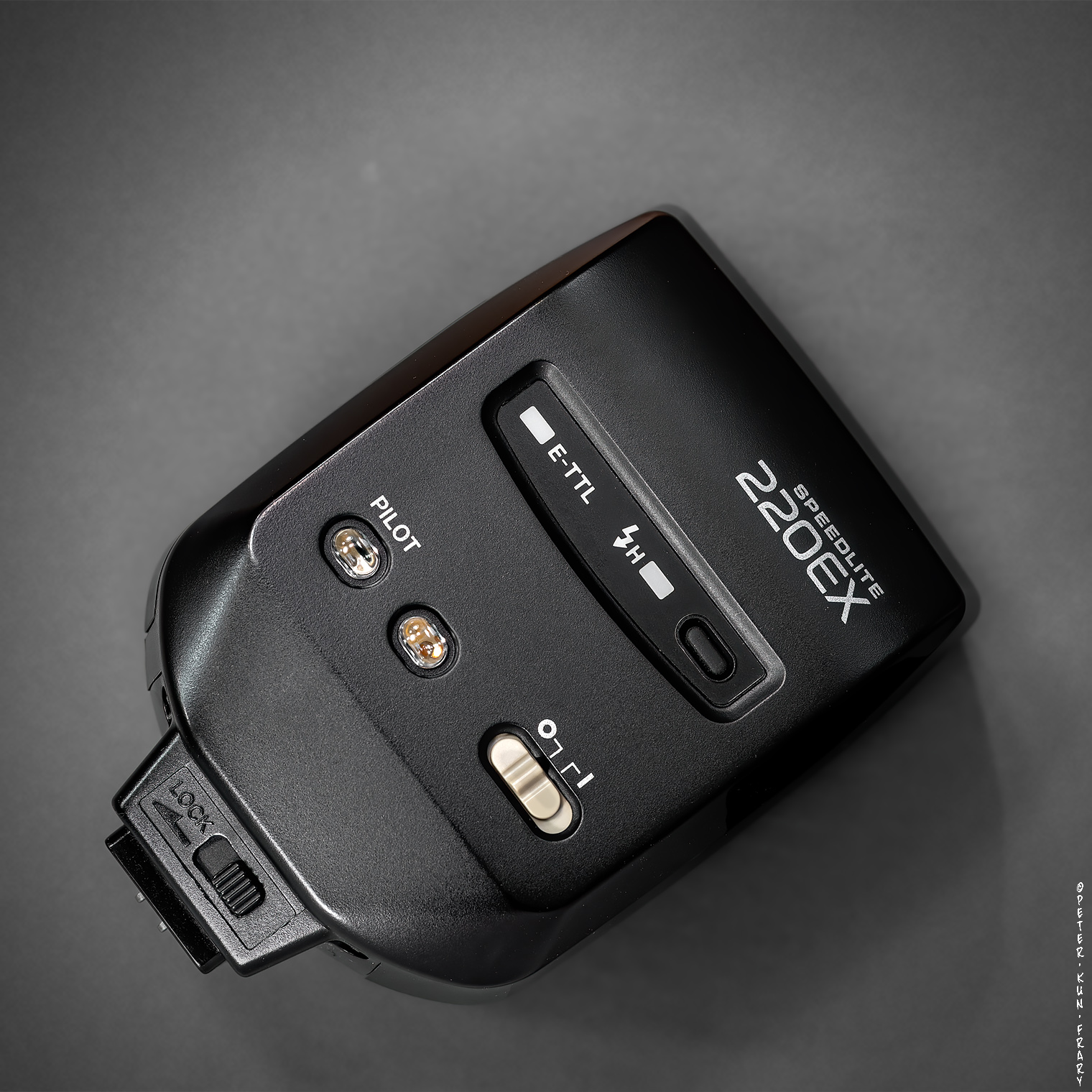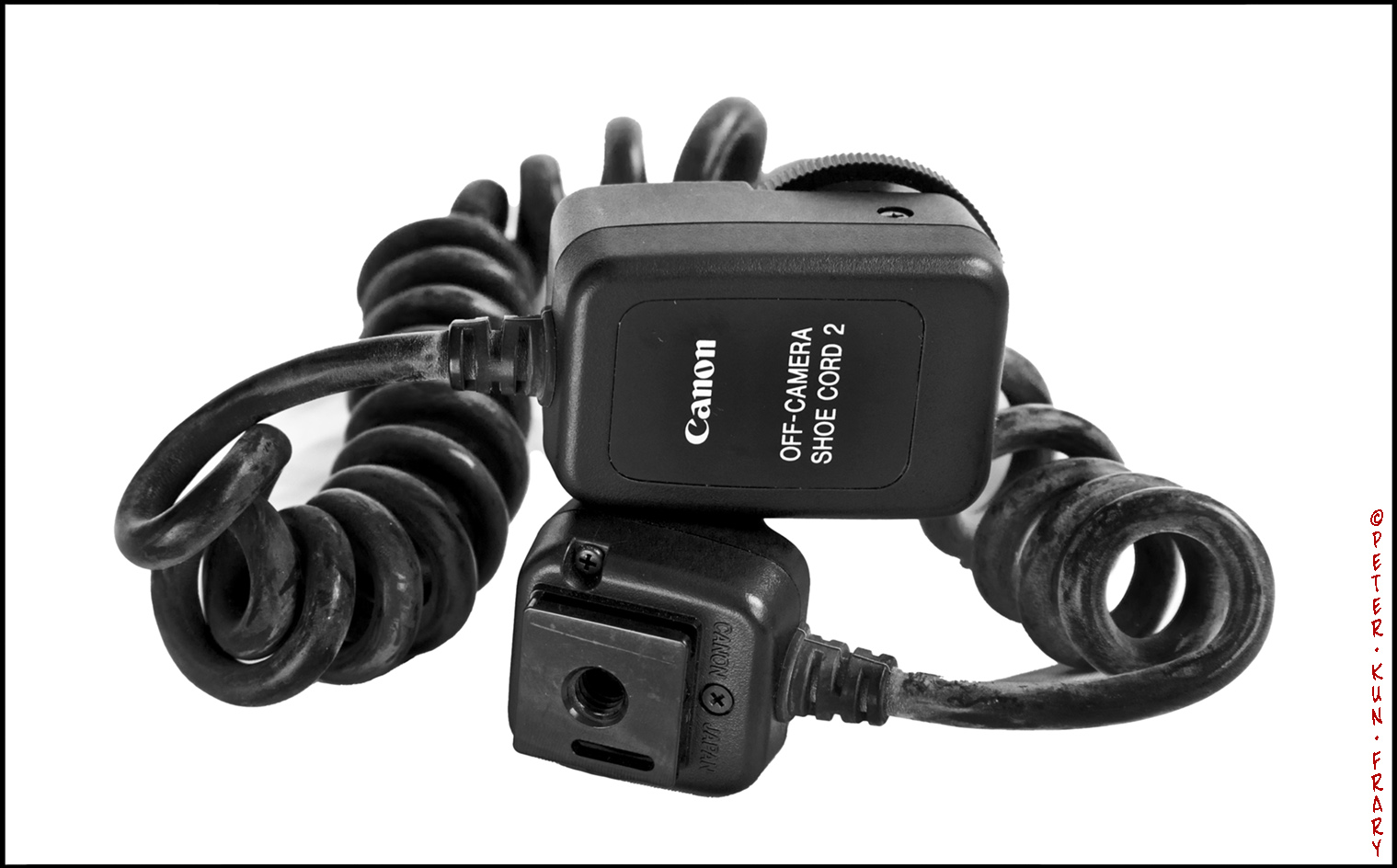|
.•••
Canon 220EX Speedlite
E-TTL Pocket Flash
Peter Kun Frary
.
.
In this article I revisit an old favorite travel flash unit of mine, the Canon Speedlite 220EX. I bought the 220EX in 1999 and, over 20 years later, it's still going strong as my travel flash. It's no longer available new, but used units are common as this flash was on the market for nearly 15 years.
Canon Speedlite 220EX | Pocketable E-TTL flash with AF assist light.

 Construction Construction
The Speedlite 220EX is almost wholly made of plastic but feels sturdy in hand. It's petite—about the size of a pack of cigarettes—and small enough to carry in a shirt or coat pocket. I power it with four AA lithium batteries to keep weight as low as possible. Despite the small size, recycling time is fast, 0.1 to 4.5 seconds with alkaline AA batteries or 0.1 to 2.5 seconds with rechargeable Ni-Cd or Nickel-Hydride AA batteries. Sadly, Eneloop rechargeable batteries are too long and prevent the battery door from closing.
The shoe lock of the 220EX is simple to use. Once mounted, you simply flip a latch to lock it. More convenient than the thumb wheel on some flash units.
Québec libre! | EOS 5D, EF 24-105 4L IS USM and 220EX | I used FEC to juice power and help illuminate the sculpture against the back-light of the sun.

Although compact, the 220EX is surprisingly powerful: Guide Number 22m (72 feet) at ISO 100, 28mm full frame coverage (17 or 18mm APS-C).
The back panel of the 220EX is almost barren: flash exposure confirmation light (green), FP flash button (high speed sync), pilot button (test fire and red ready light) and on-off slider. The E-TTL and HSS symbols illuminate when activated.
Canon Speedlite 220EX | On-off switch, Pilot (ready light and test button), FP Flash button (HSS) and flash exposure confirmation light.

 Compatibility Compatibility
The 220EX was discontinued in 2009, so does it work with newer cameras? Yes, it works fine with any EOS DSLR model using E-TTL or E-TTL II flash metering, basically all EOS DSLRs and mirrorless cameras. During last two decades, I used the 220EX on a 5D, 5D MKII, 6D, 6D MK II, 7D, 10D, 20D, 40D, 50D, 60D, 70D, 80D, 90D, R and R7 and it was plug 'n play for basic flash operations.
Advanced features like second-curtain sync and FE Lock (flash exposure lock), flash exposure compensation are accessed via camera controls and/or the flash menu. Incompatible features are grayed out. For example, the EOS 6D flash menu shows FEC, second curtain sync, E-TTL II and Averaging flash metering, sync speed in Av mode and enable/disable flash firing. However, flash bracketing, power ratios, and wireless options are absent. On the EOS R7 flash menu, options I've never seen before were included: face and ambient priority flash metering, and setting a range of shutter speeds in different flash modes.
The 220EX uses E-TTL, E-TTL II or TTL depending on the specification of the camera in use. For example, the 1990 EOS 10S will automatically use TTL whereas the 2019 EOS 90D activates E-TTL II.
Balanced Fill-in Flash | EOS 5D, EF 24-105 4L IS USM & 220EX | Auto balanced fill flash in Av mode.

E-TTL Flash Metering
When you press the shutter button, the 220EX fires a low power preflash to determine flash exposure a split second before exposure. The preflash is so near the main flash it appears to be a single flash, not two flashes. The camera's Evaluative meter is used to measure both ambient light and flash. In most modes the camera balances both flash and ambient light for a natural appearance.
Fill-in Flash
In bright light, EV 10 and above, the 220EX provides automatic fill-in flash in Full Auto and P modes. In dim light, below EV 10, flash is the main light in Full Auto and P modes (the background may be dark). Av, Tv and M modes deliver automatic fill-in flash in any light, even at night (slow sync). Slow sync results in a natural balance between ambient light and flash. However, you may need a tripod due to the resulting slow shutter speeds.
Main Street Station | EOS 5D, EF 24-105 4L IS USM and 220EX | Auto balanced fill flash in Av mode.

The active focusing point is linked to metering and, thus, flash exposure. In other words, there is an exposure bias in favor of the object you focus on. This design also means you should avoid the lock-AF-recompose technique or suffer unpredictable results. Why? Flash exposure is determined at the moment of exposure (a split second before exposure for E-TTL and during exposure for TTL). If the active AF sensor is over something other than your subject—e.g., a black void—you'll get incorrect exposure. If you can't live without the lock-AF-recompose technique, Canon designed FE Lock for you (see below).
Fill-in Flash | EOS 5D MK II, EF 24-105 4L IS USM and 220EX

As mentioned above, the 220EX balances flash and background light in Av, Tv and M modes. There is a flash reduction of -.5 to -1.5 stops depending on the strength of the ambient light. This balance makes the subject look natural, but is too perfectly blended with the background for some tastes, especially under dim lighting conditions. When I want the subject to stand out from the background, I dial in +.5 or +1.0 of flash compensation or use P mode. P mode uses the flash as the main light—full power flash—under dim conditions (EV 10 or lower).
FE Lock & FE Compensation
FE Lock is great for off-center subjects or troublesome highlights that fool the meter. FE Lock works like a spot meter for flash. First, place the center AF sensor on your subject and press the AE/FE Lock button. The 220EX fires a low power preflash. Exposure is determined by the reflectance of the subject in the partial metering circle, so be careful what you aim at. Use a medium toned area for best results. Finally, you have 16 seconds to recompose and shoot. The flash will expose the subject correctly even with usually light or dark backgrounds or an off-center subject.
The FE Lock preflash isn't people friendly as being flashed in the face once for metering and a second time for the exposure tends to be irritating. If you frequently shoot people, you'll be more popular if you apply flash exposure compensation and forgo FE Lock.
If you intend to use FE Lock on an unusually light or dark object—a white wedding dress—apply flash exposure compensation first (it doesn't work after FE Lock): subtract 1 to 2 stops of flash compensation for dark subjects and add 1 to 2 stops of flash exposure compensation for light subjects. Why? Spot or partial meters are calibrated to read 18% gray tones. No matter where you point, the camera expects a medium tone (18% gray) and gives you the correct meter reading for this result.
Fashion Show Mall | EOS 20D, EF-s 17-55 2.8 IS USM, 220EX, +2/3 FEC

 High Speed Sync High Speed Sync
FP flash, also known as high speed sync (HSS), allows you to sync at any shutter speed, albeit with significant loss of power so this is best used at close distances (10 feet or less). This is great for daytime fill flash as it allows use of large apertures. However, FP Flash works best in Av, Tv and M modes where the user has control over aperture and/or shutter speed. When a Speedlite is mounted on the any EOS camera, P and DEP modes are not shiftable making these modes almost useless for FP Flash. Moreover, P mode tends to favor smaller apertures over faster shutter speeds when a Speedlite is mounted.
 AF Assist Light AF Assist Light
Focusing in the dark is quick and discreet thanks to the near-infrared AF assist light. The AF assist light has a range of about 16 feet (5m). With the 220EX mounted, low light AF is vastly improved. Unfortunately, the AF assist light of the 220EX only covers the center AF area. It affords no off-center coverage for multiple AF point arrays. However, the top, center and bottom sensors are covered by the AF assist beam. With 45-sensor arrays—EOS 1V or 3—it only seems to work with the center AF sensor. Oddly, the near-infrared AF assist light is disabled if you mount this flash (or any other Canon Speedlite) on an R series camera. Nevertheless, I find the near-infrared AF assist light a welcome feature for DSLR shooters and preferable over the disco strobe AF assist of the 270EX.
When used on mirrorless cameras such as the EOS M6 or R7, the AF assist light of the 220EX is disabled. Apparently Dual Pixel AF is not compatible with the red (near IR) light of these cameras.
Flash Exposure Confirmation Light
The 220EX has a flash exposure confirmation light next to the Pilot Light. If flash exposure is accurate, it glows green for 3 seconds. If it doesn't glow, move closer and try again. Hopefully, Canon will someday put a flash exposure confirmation light in the viewfinder of all its cameras!
Haleiwa | EOS 5D2, EF 24-105 4L IS USM & 220EX | I dialed down the sky (ambient) a bit to give the sign a little pop.

 Final Blurb Final Blurb
Why use an external flash instead of a built-in popup flash? Even a small external flash such as the Speedlite 220EX is twice as powerful as a popup flash, providing more power for group portraits or back-lit subjects posing against the setting sun. Plus, a shoe mounted Speedlite is less prone to red eye because it is further from the lens axis. With the Off-Shoe Cord 2, the 220EX may be used off-camera for better modeling, macro work or bounced off a wall or ceiling for softer light.
Off-Shoe Cord 2 | The OSC2 connects to the hot shoe and Speedlite, allowing shooting with the flash on a bracket or in your hand.

The 220EX was replaced by the 270EX in 2009. Why use a 220EX when you can get a newer design with similar power (GN) like the 270EX II, 320EX and EL-100 for under two Benjamins? Most small flash units are cursed with a pulsing strobe for AF assist. I hang onto my 220EX because it's one of the smallest E-TTL Speedlites available with near-infrared AF assist. Plus, for travel, I only need basic E-TTL features—I never use bounce or wireless while bar hopping, hiking or visiting casinos!
After two decades of steady use, my 220EX has proved to be dependable. It's a wonderful blend of simplicity and power in a petite package that fits in your pocket or purse. However, if you need tilt and wireless features in a small flash, this flash is not for you.

 Specifications Specifications
- Coverage: 28mm (24mm for APS)
- Recycle Time: 0.1-4.5 sec (alkaline batteries) | 0.1-2.5 sec (Ni-Cd)
- Guide Number: 22m (72 feet) at ISO 100
- Flash range: .7m to 15.7m with EF 50 1.4 lens at ISO 100 (2.3 feet to 24.9 feet)
- Flash count: 250 to 1700 depending on distance
- Exposure Compensation: -2 to +2 in half stop increments (on-camera controls only)
- Exposure Modes: E-TTL, TTL, and FE Lock (E-TTL only)
- Flash Modes: Normal, High Speed Sync, Test Firing and 2nd Curtain Sync
- Head: Fixed (no swivel or tilt)
- AF Assist Light: Covers only center AF sensor
- AF Assist Light Range: 5m (16 ft)
- Batteries: 4 AA | Alkaline, Ni-Cd, Nickel-Hydride or Lithium
- Weight: 160g (without batteries)
- Size: 65mm (W) x 92mm (H) x 61.3mm (D)
- Accessories: pouch and instruction manual
- Made in Japan
- Street Price: $50 to $60 (used)
 Reference Reference
Canon Speedlite 220EX Instruction Manual. CT1-7766-002. Canon, 2008.
03/17/2002 | Revised 11/07/2023

©Copyright 2002-24 by Peter Kun Frary | All Rights Reserved
|